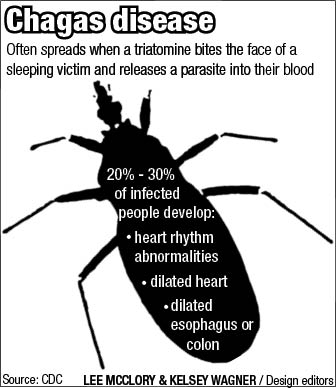Getting a smooch is a good thing, right? Well, not always.
It’s estimated that more than 300,000 people have been infected by Chagas disease in the United States, according to the Centers for Disease Control and Prevention.
The disease is transmitted by an insect, called a triatomine, which is commonly referred to as the “kissing bug.”
The insect got its name from its common practice of coming out at night to bite a person’s face, effectively transmitting the Chagas disease, said Brad McGwire, an assistant professor in the Department of Internal Medicine’s Division of Infectious Diseases at the Ohio State Wexner Medical Center.
McGwire recently traveled to São Paulo,where he conducted research into the parasite that causes Chagas disease.
Chagas is endemic only in certain countries in Central and South America and is also found in Mexico, he said.
According to the CDC, kissing bugs have also been reported in Ohio.
When the kissing bug bites its host, it will defecate or urinate into the wound and transmit the parasite, McGwire said.
Kissing bugs are not the only way that Chagas disease is spread, though. The parasite can also be transferred congenitally (from birth), through organ transplantation and blood transfusion, and orally through drinking infected juices or eating undercooked meat from an infected animal.
“Many times the there are no symptoms of acute infection, although sometimes the symptoms are nonspecific, flu-like symptoms,” McGwire said. “In a small proportion of those acutely infected, particularly very young children, it can be deadly in the acute phase.”
Thirty percent of patients go on to develop symptoms of chronic infection, which include heart failure, mega-organ syndromes and some central nervous system effects, McGwire said.
“If (Chagas disease) is detected early … it can be treated using anti-parasitic medications,” he said.
Still, McGwire said there are no effective vaccines yet developed for Chagas disease.
“Overall, it is thought that there are probably up to 20 million people with Chagas with up to 50,000-100,000 deaths per year,” he said.
There have been no diagnoses of Chagas disease in Franklin County, Jose Rodriguez, spokesman for Columbus Public Health, said in an email.
Melanie Amato, spokeswoman from the Ohio Department of Health, said Chagas disease is not reportable in Ohio.
“That means that unless there is an outbreak, local health departments or doctors do not have to report it to the state,” Amano said in an email.
McGwire said the southern parts of the U.S. in particular, such as Texas, Arizona and New Mexico, have populations of kissing bugs, but most reside in animals, not humans.
“Humans are rarely infected here because good housing and sanitation prevent the contact of infected insects with humans,” he said.
One OSU student, Chase Pinkerman, a second-year in English education, had never heard of the kissing bug before. He shuddered at its description.
“I don’t ever want to see them ever in my life,” he said. “Ever.”
Pinkerman said he feels safer knowing there are not any reported cases of Chagas disease in Ohio, but still feels ill at ease with the bug in general.



